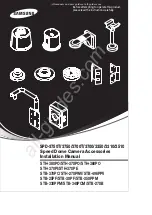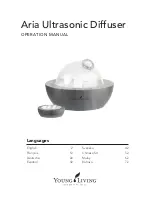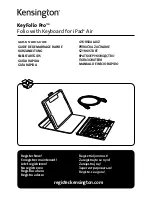
BEFORE YOU BEGIN
Good craftsmanship begins and ends with good work habits, so make
the following steps part of your routine workshop practice. If you have
any doubts or questions about how to proceed with a project, always
discuss them with your shop instructor.
• Carefully and fully review plans and instructions before putting a
tool to the project lumber.
• Work sensibly and safely. Wear safety goggles when doing work that
creates flying chips and sawdust; wear the appropriate respirator
whenever making sawdust or working with thinners or other solvents.
• At the end of every work session, clean up your shop area and put
away all portable tools.
CUTTING AND ASSEMBLY
PROCEDURE
1.
Cut parts A, B and C to length and width.
2.
Set up dado blade on the table saw to make 1/2"-wide cuts. Cut
grooves into parts B and C, located as shown in Fig. 1.
3.
Set up dado blade for 3/4"-wide cuts. Cut rabbets on ends of B as
shown in Fig. 1. Use a backer block behind the end you’re cutting to
prevent blowout.
4.
Set up the dado blade for 3/8" cuts. Cut 1/4" x 1/4" rabbets on all
edges of part A, ends first, then sides. Because this is a flush cut to
the table saw fence, you’ll need to attach a sacrificial wood fence.
Set the fence for the right cutting dimension and then raise the dado
head into the sacrificial fence. Make test cuts to assure the dimensions
are correct.
5.
Clamp together parts A, B and C to test fit. If needed, adjust the size
of part A for proper fit.
6.
Cut the goal openings in parts C so that the bottom of opening is
dead flush with the top of the 1/2" groove. One way would be to drill a
1/2" access hole in the waste, then use a jigsaw and fine-tooth blade to
cut the opening. Make sure not to cut too close to the line at the bot-
tom edge, where it meets the dado. Then clamp both ends (C)
together, and clean up the cuts with files (flat and half-round).
7.
Drill the ends of parts B for the 3/8" plugs, then drill the clearance
holes for the woodscrews.
Making the Corner and Goal blocks, Sticks and Puck
8.
Cut the corner and goal blocks to the dimensions shown in the
CUTTING LIST. Instead of using 8/4 hardwood, they can be glued up
from the width of two pieces of less expensive 3/4" wood. Sand the edges
smooth and even.
9.
Make a cardboard template of the hockey sticks as shown in Fig. 2.
Trace the shape onto 1/2" hardwood. Lay out the puck on 1/2" hard-
wood or plywood. Cut the sticks and the puck using a bandsaw or
scrollsaw; round corners with a file, sand.
NOTE:
Assembly must be done after all the pieces except the outsides
of B and C are stained and finished, so proceed now to STAINING AND
FINISHING.
10.
Dry clamp the sides and playing surface together one last time to
check the fit.
11.
Apply carpenter’s glue to the grooves and rabbets, clamp the pieces
together and set the assembly aside to allow the glue to dry.
12.
Drive screws into the joints, apply glue to plug holes and drive in the
plugs. Remove the clamps. Trim the plugs flush using a small handsaw,
then sand flush. You can now sand, stain and finish the outside.
13.
Screw on blocks to the plywood, positioned as shown in Fig. 1.
14.
For a no-scratch base, add felt or rub-on buttons to the bottom
four corners.
STAINING AND FINISHING
Woodworker’s Tip:
Though you may be tempted to cut short
your sanding, preparation and application time, don’t do it.
These tasks are very important steps in obtaining a high-quality
finish. Remember, it is the finish, just as much as the fit and
smoothness of the parts that will have great bearing on how
people judge your craftsmanship. To ensure an excellent result,
follow the steps listed in this section and also the instructions
the finish manufacturer puts on its products.
FINISHING TIPS
• Test the stains and finishes you are planning to use on scraps of
wood. On the back of the scrap, mark the stain/finish combination
and the type of wood. Allow all samples to dry thoroughly before
making your final finish selection. Save your samples for quick
reference on future projects.
• All stains and finishes must be allowed to dry thoroughly between
coats. Remember that drying times can vary due to humidity and
other climatic conditions.
• If you have some leftover stain or finish, wipe the can rim so that
stain or finish in the rim won’t dry out and prevent the lid from
forming a tight seal.
• Brushes used for water-based products, such as Minwax
®
Water-Based Wood Stains or Minwax
®
Polycrylic
®
Protective
Finish, should be cleaned with warm water and soap; for oil-based
finishes, brushes must be cleaned with mineral spirits.
15.
Sand all pieces with 120-grit sandpaper, then move up to 220-grit
to complete the pre-finish smoothing. Use an orbital sander and with-
the-grain sanding strokes to remove any marks or scratches. Dust off
the piece and wipe it carefully with a clean, lint-free cloth lightly damp-
ened with water.
Recommended Finish
16.
Before applying Minwax
®
Water-Based Wood Stain to a hardwood
or softwood, apply Minwax
®
Water-Based Pre-Stain Wood Conditioner
following the directions on the can. Applying it will help to ensure even
absorption of stain and prevent blotchiness that can occur with some
woods. After 1 to 5 minutes, wipe off all excess conditioner using a
clean, soft cloth. Wait 15 to 30 minutes then use 220-grit or finer sand-
paper to sand off any “whiskers” raised by the conditioner. Wipe-off
any sanding dust with a clean, soft cloth. Proceed to the staining within
2 hours.
–3–
CONTINUED - WOODWORKS: BEGINNER PROJECT TABLE HOCKEY

























